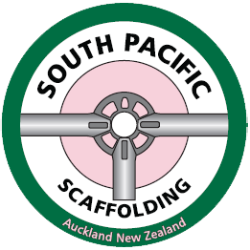If the scaffolding needs to be higher than 5m, you need a licensed professional.
By New Zealand law, any use of scaffolding above 5m is considered working at heights, and therefore considered high-risk work. In order to conduct such work, a licensed professional needs to be present. So if at any point you are working at a height where people or materials can fall greater than 5m, it will require you to obtain this licence. This pertains to the erection, alteration or dismantling of the scaffolding equipment.
Your best bet is to hire a professional to assemble the scaffolding
Scaffolding is an incredible tool in boosting both the efficiency and safety surrounding a project. However, the caveat to this is that scaffolding incorrectly assembled does the complete opposite. One of the biggest safety concerns with scaffolding is ensuring that the assembled scaffolding is safe to support maximum loads. If you hire your scaffolding off a reputable company (such as South Pacific Scaffolding), they will also organise a certified professional to erect and dismantle your scaffolding equipment. This will include all the necessary paperwork and inspection schedules.
But what happens if you have decided to purchase the scaffolding yourself? Even in this case, it is still highly recommended that you hire a professional to assemble your home scaffolding. Consider the fact that scaffolding is one of the most important elements in a safe building environment and hiring a professional to assemble and inspect your scaffolding before use ensures that it is working as intended. A malfunctioning scaffolding system can be tremendously hazardous.
Knowing the most common causes of injuries is the first step in preventing them.
Human error is easily one of the most common causes of injuries while using scaffolding. This is why it is highly recommended that you have an experienced person looking over your scaffolding system. You should also take the time to learn and understand the fundamentals of scaffolding safety. There are plenty of resources on youtube, online, and even training courses that you can attend that will greatly assist you in managing risk when it comes to DIY projects and house scaffolding. Being able to recognise the most common injuries related to scaffolding is your first line of defence in ensuring that you are carrying out your DIY project in a safe manner.
There are three common causes of injuries when working with scaffolding. The first being scaffolding platforms or structures failing and falling over. This is followed by falls related to incorrect scaffold assembly and finally, being struck by falling materials/items below the scaffolding structure. As you can see, these can all be avoided given the correct oversight by a scaffolding professional such as South Pacific Scaffolding.
Every year, thousands of kiwis take on DIY projects. At South Pacific Scaffolding, we celebrate the idea of kiwis taking it upon themselves to do the work and understand that a DIY approach can be a highly cost effective solution. There’s also a particular sense of rewarding satisfaction that comes along with putting all the pieces together yourself. With that being said, many of these DIY projects do require the use of scaffolding, so safety should always be your number one priority. At South Pacific scaffolding, we take pride in our stellar safety record. Let our high level of experience in scaffolding safety be your guide to a successful DIY project. For more information on all the services on offer from South Pacific Scaffolding, get in contact with our team today!

